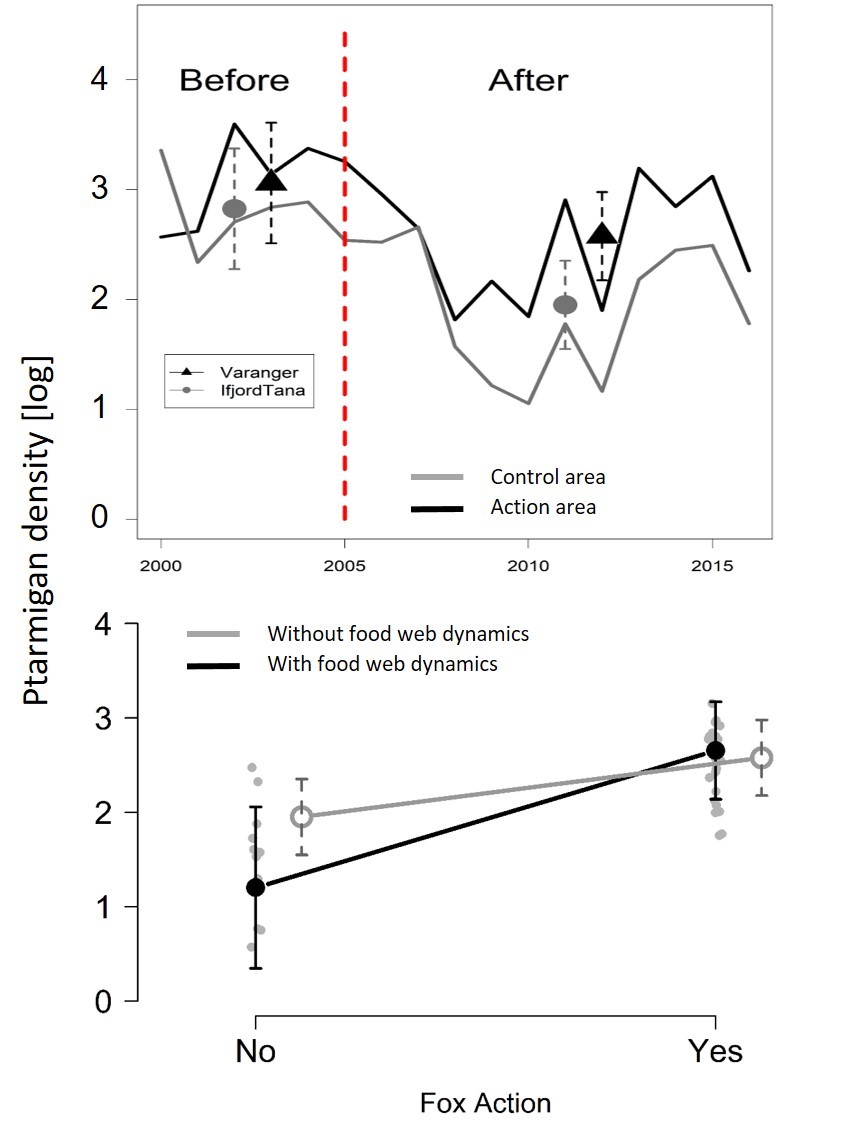Management of endangered species by culling mesopredators is increasingly common. To what extent such programs work as intended, is less clear. In a new study, COAT researchers evaluated the impact of red fox culling on a threatened ptarmigan species.
Increasing populations of mesopredators, such as foxes and corvids, are in many places suspected to cause declines in vulnerable wildlife. This has led to mesopredator decimation actions (culling) becoming a common management action. However, many mesopredators are highly mobile and resilient. Therefore, culling actions need to be intense, long-term and operate on large scales, which leads to logistical and financial constraints. This represents a common challenge to impact assessments of large-scale management interventions, which would require a proper spatial replication of action and controls. Hence, extensive temporal replication (i.e. time series) and accounting for potentially confounding drivers may alleviate this problem.
In alpine-arctic tundra, the red fox (Vulpes vulpes) has been increasing during the last 50 years. Simultaneously, many bird species have declined, including the willow ptarmigan (Lagopus lagopus), likely due to increased predation. In a new study (Henden et al. 2020 JApplEcol), we have assessed the impact of a long-term (12-year) and spatially extensive (~3500km2) red fox decimation program on the red listed willow ptarmigan (Lagopus lagopus) in the Norwegian low Arctic. Ptarmigan populations have been monitored annually in both the impact area and in an adjacent no-action area, including a 5-year period before the action commenced.
A Before-After-Control-Impact-Paired-Series (BACIPS) analysis without food web covariates revealed that red fox decimation has likely curbed the decline of the ptarmigan population in the impact area, resulting in a ~25 % higher density compared to the no-action area. However, the dynamics of other drivers within the food web masked the effect in the simple BACIPS analysis. Hence, accounting for three food web drivers (small rodent abundance, carrion availability and ptarmigan harvest) as covariates in the statistical model, resulted in a more unbiased impact estimate that amounted to ~40 % higher ptarmigan density (4.3 more ptarmigan/km2) in the red fox impact area.

Figure. Upper panel: Time series of ptarmigan density (log). Aligned are estimates from the BACIPS analysis of mean density (with 95% CI) before and after the fox culling action for the Varanger impact region and Ifjord-Tana control region, respectively.
Lower panel: Estimated impact of the red fox culling action on ptarmigan population density (log-scale) adjusted for the influence of food web covariates (black line and filled symbols). For comparison, dark grey line and open circles denote the unadjusted estimates from the BACIPS model (“After”) in the upper panel.
With this study, we are among the first to provide evidence of the role of the recent expansion of red fox in the decline of tundra bird populations. Interestingly, we show that red fox decimation programs may curb such declines, given that management actions are large-scale and long-term. The accuracy of impact assessments can be increased by conducting and including proper monitoring of drivers of food web dynamics that also affect the target species. This is especially relevant for declining bird populations in boreal and arctic food webs, which are governed by strong multi-annual interaction cycles (e.g. small rodents).
Full paper